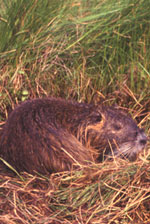Threats to Birds - Nutria (Myocaster coypus)
Overview
A semiaquatic rodent, nutria are native to southern South America. They were introduced into the U.S. between 1899 and 1940 primarily for fur farming in California, Washington, Oregon, Michigan, New Mexico, Louisiana, Ohio, and Utah. Many nutria from ranches in those states were released into the wild when the businesses failed in the late 1940s. State and federal agencies and individuals introduced nutria into other states to control undesirable vegetation and to enhance trapping opportunities. Feral nutria have now been reported in at least 40 states since their introduction, and approximately 1/3 of those states still have viable populations that are stable or increasing in number. Populations are most dense along the Gulf Coast of Louisiana and Texas. Some populations are economically important to the fur industry. From 1977 to 1984, an average of 1.3 million nutria pelts were harvested annually worth approximately $7.3 million. Nutria can be extremely damaging to freshwater wetlands, turning marsh into open water. Nutria also girdle trees. They feed on seedling bald cypress and can cause the complete failure of planted or naturally-generated stands.
Description
Large, dark-colored, semiaquatic rodent with short legs and a 61 cm long body. Tail is round, scantily haired and 33 - 41 cm long. Average weight is 5.4 kg (12 lbs) but may grow to 20 lbs. Hind feet are webbed, incisors are large and yellow-orange to orange-red in color. Can swim long distances under water. Almost entirely herbivorous, eating roots, rhizomes, tubers and other parts of plants. Live on the ground in dense vegetation and also use burrows. Breed year-round and can reach sexual maturity at four months of age. Litters average 4-5 young. Nutria can be infected with several pathogens and parasites that can be transmitted to humans, livestock, and pets. They may also host nematodes and blood flukes that cause “swimmer’s-itch,” the protozoan responsible for giardiasis, and tapeworms.
Birds Affected
Black Rail; wading birds, waterfowl.
Control
Nutria are protected as furbearers in some states because they are economically important, but in others they have no legal protection. Blackwater National Wildlife Refuge, MD, was losing 500 - 1,000 acres of marsh per year to nutria damage. However, as of November 2004, after $2 million and 15 trappers worked for 2 years, Blackwater NWR has been declared free of nutria. Zinc phosphide, highly toxic to wildlife and humans, is the only toxicant that is registered for controlling nutria, and can only be purchased and applied by certified pesticide applicators. Leg-hold traps are the most commonly used traps for nutria. |
